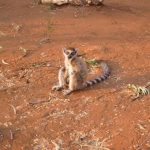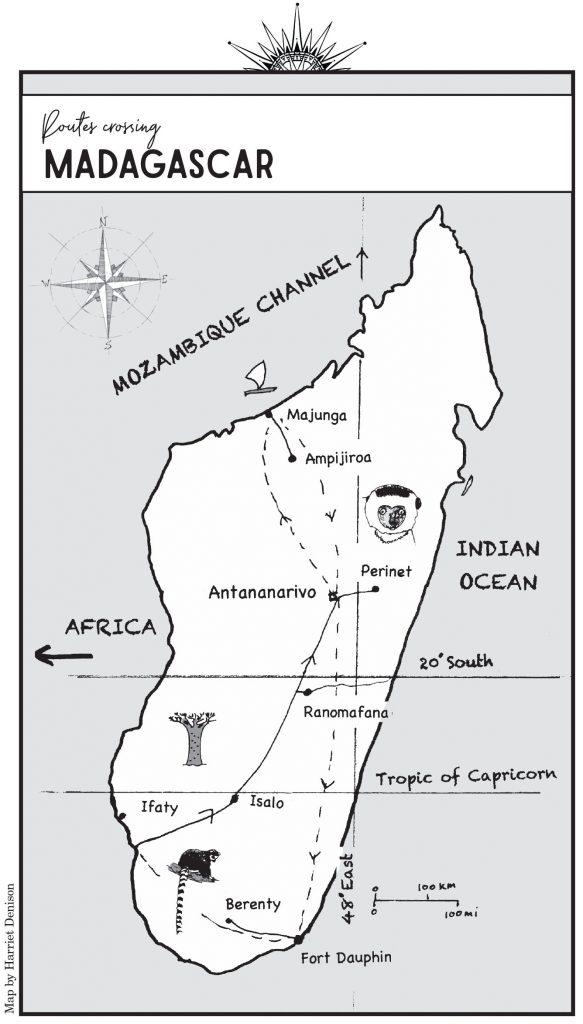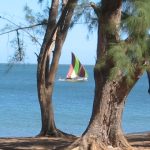- Introduction to Madagascar
- 1. Northwest Madagascar
- 2. Ankarafantsika National Park
- 3. Traveling to Southern Madagascar and the Lemurs
- 4. Among the Lemurs of Southern Madagascar
- 5. The Spiney Forest of Southwest Madagascar
- 6. On the Road to Isalo National Park
- 7. Ranomafana National Park, Our First Rainforest
- 8. A Country Market and a Bit of Culture
- 9. Birds, Kids and Lemurs at Perinet Reserve
- 10. Leaving Madagascar
Introduction to Madagascar
A few months after my 2001 tour to Antarctica, I shared lunch with four new friends from that trip. After thoroughly discussing our previous excursion, reminiscing about the exciting times and difficult moments, someone boldly asked, “Where to next?”
Immediately, I said, “Madagascar!” And another friend chimed in, “Yes, Madagascar!”

It was the lemurs that drew me to Madagascar. Sweet, cute, and silly in all the photos and videos I had seen. The opportunity to be in their presence and to watch them just be themselves in their natural habitat seemed like an incredible adventure. Our enthusiasm infected the other women at lunch and the unanimous decision to visit that remote and mysterious land made us giddy with excitement.
Then I did some research. Alison Jolly Ph.D., a zoologist and a primatologist known for her studies of lemur biology, had studied lemurs in Madagascar for 25 years and was the first one to propose female dominance in a primate society. I liked that connection. She wrote the following in a fascinating, but discouraging article in the February 1987 issue of National Geographic:
Madagascar has more than enough fertile land left to feed its people if the land is farmed for high yield. And with proper management, enough forest still stands to make Madagascar self-sufficient in fuel as well as to preserve most of its unique plants and animals.
Sadly, later reports confirmed that Dr. Jolly’s suggestions had been ignored. As I considered actually going to Madagascar, I knew this country’s fragile environment had already been overrun by a growing population. My tumultuous inner arguments went on and on. Go now before there is nothing left to see, and then, Go now to validate that saving what wildlife remains could bring money to a desperately poor country.
But then, my inner debate turned to this: Tourism can be a mixed blessing, as other developing countries have discovered; tourists can “love” a fascinating and beautiful place to ruin.
Ultimately, I decided I had to go. The opportunity will never come again, I told myself.
A friend had recommended Mark Smith, a Portland-based leader of nature tours, who offered a three-week tour of Madagascar that promised both lemurs and birds, as well as other unusual creatures that would certainly cross our paths. This seemed like the best option for my fellow travelers and me.
It took three years for all of our schedules to finally mesh, but early in 2004 we signed up for the October nature tour. In the end, this became a trip that stands out as one of the most extraordinary journeys in my many years of worldwide travel.
What Makes Madagascar So Unusual?
Madagascar is the fourth largest island in the world, and is about twice the size of Arizona. In grade school, I remember noticing that the opposing shorelines of Madagascar and the east coast of Africa fit together like pieces of a puzzle. What a surprise to learn that it was once a part of Gondwanaland, the ancient landmass that broke apart some 180 million years ago and became Africa, Antarctica, South America, Australia, and the Indian subcontinent. My childhood observation was correct.

Madagascar is located in the Indian Ocean, directly east of the African country of Mozambique. The wildlife that existed on that drifting scrap of land evolved, isolated from relatives on the larger continents of Africa and Asia. According to current scientific thought, additional animals and plants that now live in Madagascar may have floated across from Africa on storm-ripped trees, adding diversity to the slowly changing populations of flora and fauna on Madagascar.
Lemurs are only found on Madagascar and are believed to be descendants of the pre-primates of Gondwanaland. At least half of all species of lemurs once in existence are recorded only from fossils. Scientists speculate that one ancient lemur weighed up to 440 pounds. Today, 101 species and subspecies of lemurs survive on Madagascar and all are endangered.
Of the 258 bird species identified on Madagascar, 115 are endemic, meaning they are found only on this island. In addition, 90 percent of the island’s other living species are endemic, making Madagascar one of the most ecologically diverse places on earth.
Early Inhabitants
Before the first settlers arrived, a variety of habitats covered Madagascar, from desert scrub in the south to tropical dry forest further north and west, and tropical rainforest near the eastern coast. Today, 80 percent of Madagascar is barren due to repeated plowing and intentional fires that support subsistence farming.
Scientists are still researching the early human history of Madagascar. Anthropologists believe the first migrants arrived from Borneo, Indonesia about two thousand years ago, sailing in outrigger canoes on the same trade winds used by their merchant-ancestors. Over many years, the earliest settlers found the island’s central highlands to be the best land for growing the rice they brought with them from Borneo, so this is where they eventually concentrated their tribal settlements. In the mid 1500s, the most powerful chief, Andriamanelo, united the highland tribes into one group called the Merinas, which is now the most politically powerful ethnic group in Madagascar.
Remnants of 9th century coastal fortifications built by Arab traders are the oldest signs of occupancy, and Europeans later built forts there to protect their own interests in the trade among Africa, the Middle East, and Asia.

The name Madagascar emerged when Marco Polo landed there in the 13th century. He thought he had landed near Mogadishu in Somalia on the east African coast, an active port for Arab traders at the time. The name “Madagascar” is a corruption of “Mogadishu,” but the name stuck, and it gained popularity during the Middle Ages.
The Bantus from East Africa sailed to Madagascar about one thousand years ago and first settled on the northwest coast then migrated to other coasts. In the early 17th century, the Merinas subdued the scattered Bantu tribes and ruled the island until the 1800s. As conquerors, the Merinas forced the Bantus to work as slaves and sold them into the slave trade.
The first Europeans attempted settlements on Madagascar in the 1600s, but with limited success. European Christian missionaries came and went, depending on the favor of the ruling Merina monarch. In the early 1800s, the Merinas controlled all of Madagascar, and had repelled and discouraged incursions by the French and the British who both wanted a permanent port on Madagascar in order to support their trading ships bound for India. During that period of global European colonization, the French and British negotiated the control of two islands they both claimed, Madagascar and Zanzibar. They agreed that Madagascar would be under French control in return for the French ceding to the British control of Zanzibar, an important trading island off the coast of East Africa.
These negotiations had occurred without including the Merinas who were furious at the arrangement, but helpless to change it even though they tried. The Merinas cancelled trading concessions with France, which precipitated the Franco-Hova Wars that resulted in two French invasions into the heart of Merina territory in 1883 and 1890. The Merina rule crumbled and Queen Ranavalona III signed an agreement accepting the foreign influence in Madagascar. It became a French protectorate in 1895, opening the island to colonialization. In 1948 as colonialism waned, the French began a peaceful transition toward independence for Madagascar, culminating in full independence in 1960.
Today, there are about eighteen ethnicities represented in Madagascar’s population, and the largest group is the powerful Merinas, comprising 25 percent of the population. The official languages are now French and Malagasy, and many people also speak English. The year we visited, Madagascar had a population of 17 million people with 73 percent living in rural areas.
Diverse but Fragile Ecosystems
Researchers now flock to Madagascar hoping to discover another Rosy Periwinkle, a plant native to Madagascar that provided important ingredients for fighting certain forms of cancer. In spite of the intense research to date, the unique flora and fauna of Madagascar still hide their mysteries. However, as fast as scientists discover a new species another habitat is degraded. The more I learned about Madagascar, the more I felt driven to visit this unique place on the planet before it was too late. So in 2005, three years after that decisive lunch with friends in Portland, we began our journey to Madagascar.